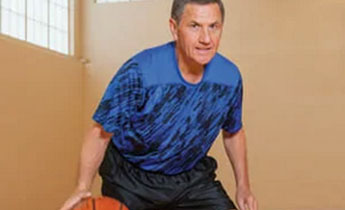Chuck Westendorf still remembers the horrifying feeling of having “uneven legs” after hip replacement surgery.
“I knew immediately something was wrong,” Westendorf said. “It was as if I grew almost two inches. When I sat, you could see my right knee was about two inches longer.”
This was the 67-year-old’s second hip surgery in three years—the first for a labrum tear and the second for a total hip replacement. “I lost three years of my life,” said the retired teacher and basketball coach. Prior to his hip problems, Westendorf filled his days walking three to four miles, playing golf, vacationing with his wife and playing with his grandson.

Westendorf isn’t alone. According to the Centers for Disease Control and Prevention, more than 300,000 total hip replacement surgeries were performed in the United States in 2010. By the year 2030, the AAOS predicts that number to rise by 75 percent to 572,000. Right now, about 10 percent of hip replacements are “revision” surgeries.
Discrepancies beyond three-fifths of an inch can greatly impact a patient’s life, says the American Academy of Orthopaedic Surgeons. Complications include chronic back pain, shoulder pain, hip dislocation and sciatica—excruciating leg pain that makes standing or sitting nearly impossible.
“Dr. Finn literally gave me my life back.”
“Mr. Westendorf was considered a high risk patient,” said Henry Finn, M.D., chief of surgery at Weiss Memorial Hospital, medical director of the Chicago Center for Orthopedics at Weiss, and professor of Orthopedic Surgery at the University of Chicago. “He was recovering from a superficial staph infection and a few weeks into healing from his primary hip replacement at another hospital. Still, I knew I could even out his right leg.”
Using a specialized surgical technique, Dr. Finn got Westendorf walking tall again. “Mr. Westendorf was fortunate he didn’t wait to correct the problem,” Dr. Finn said.
“If the patient thinks something is wrong, they should seek a second opinion as soon as possible,” Dr. Finn said. Correcting leg length inequality is much less complicated if performed within six weeks of the first procedure. “If the implant becomes well fixed to the bone, often the patient is advised to accept the inequity and use a shoe lift.”
Now, Westendorf counts himself as one of those success stories and wants to give others hope. “After surgery with Dr. Finn, I was like I used to be with the first step I took,” said Westendorf, who is back to walking three to four miles a day. “Dr. Finn literally gave me my life back.”
